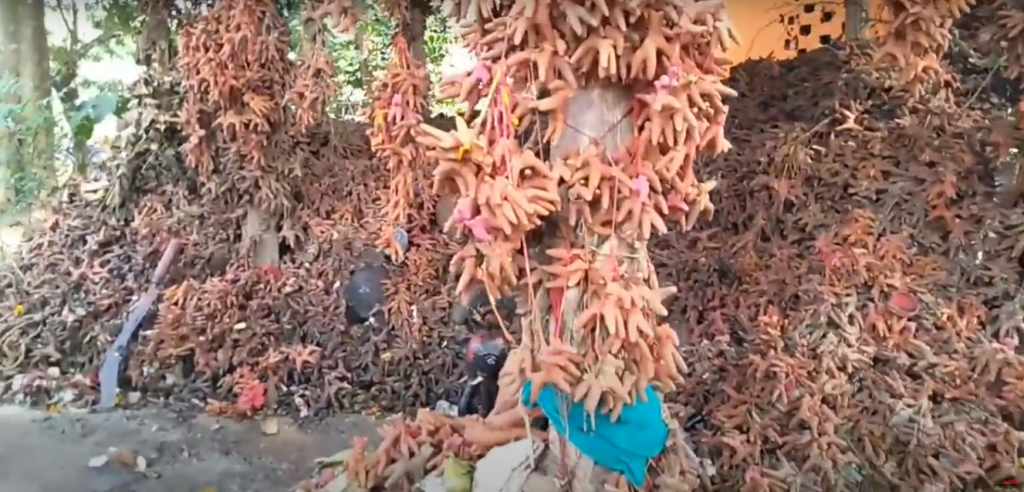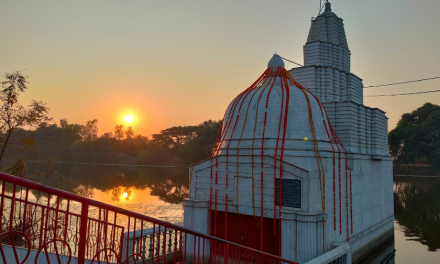Some say ‘Bana Durga'(Goddess Durga of the jungle), Others call the deity by the name ‘Bana Devi'(Goddess of the jungle). In India Pujari’s (Hindu Priests) are generally Brahmins( A section of the society who devoted their lives to the god) but for over four hundred fifty years, the puja(worship) of Devi Durga of this temple is being done by the Shabars, an Ancient tribe of forest dwellers who are considered unworthy of performing rituals for a deity by many knuckleheads. The term ‘Guptamoni’ of this deity is based on a particular dynastic and mythological incidence.
The dream
Jhargram today is a bustling city, but in ancient time, Jhargram, especially the Palace, was surrounded by dense forest. The Raja(King) Narasingha Malla Deb was bolded to unfold a hidden way to save his state and its precious revenue. Through that secret way, he made so many unnoticed attacks on his enemies and ensured his victories. Here, it is essential to mention that he consolidated his influence on a particular community named the ‘Shabar’. Coincidentally, a representative, many say the leader of the Shabars, ‘Nanda Bhakta’ by name, revealed that way during his cattle driving in the forest and informed about this surprising way to his family. The incidence took a twist from there. ‘Gaja’, the elephant of Raja Narasingha Malla Deb, was missing and was sighted by Nanda Bhakta tied in front of that said hidden way with some spinaches while taking rest beneath a tree. The Raja was commanded in his dream by the ‘Goddess Durga’ to recourse to Nanda Bhakta to find out his beloved elephant, ‘Gaja’. Raja Narasingha Malla Deb did as the Goddess instructed him. Identically on that night, Nanda Bhakta had a dream that it was ‘Goddess Durgas wish to receive worship in the ‘Shabar’ hands.
The following day Raja Narasingha Malla Deb set out to that forest and Nanda Bhakta and presented on that point of that forest. Then the Raja asked his beloved elephant, ‘Gaja’, to go back home three times, and ‘Gaja’ agreed to go with him. The next day, Raja Narasingha Malla Deb decreed his minister to set up a temple of the ‘Goddess Durga’ particularly on that point. It is a rumour that the ‘Goddess Durga’ converted on a piece of stone under a log of wood. Hence, this deity was named ‘Guptamoni’. This incident happened about 450 years ago so, it can be said that this unsleeping deity is fulfilling the wishes of her devotees for centuries taking worshipping in the hands of the Shabar and the Lodha instead of the Brahmins.
Guptamani Temple
The temple’s present building is not the initial construction. To the left side of the current structure, there is another temple that is deserted. It is a rumour that the initial temple was divided into two parts by thunderbolts. There is an Odishi style that induces the construction of the initial temple and to the top of the temple, there is a ‘Chakra of Vishnu’, which is fragmentary in its current condition. Hence, it is assumed that it was a temple of the Goddess Vishnu. However, in the year 1937, the new construction of the temple was set up. A golden idol was installed in the initial temple on heresy, but between 1903 or 1907, this golden idol was stolen. After that, an idol of touchstone was further installed. Historians say that people used to practice the horrible custom of Naraboli(Human sacrifice) in its initial days. A sacrificial altar on the courtyard supports its truth. But it was discontinued later on. From then, the Goddess of Durga was decorated with substantial golden ornaments of the landlord’s consort.
There is a giant tower situated on the roadside to the temple entrance to welcome the devotees and tourists. A ticket counter and a parking lot to a little bit ahead of the gate. A banner containing pictures of all the forest birds is to the opposite of the ticket counter, and a lodge is there beside the banner of birds. A few steps ahead from there to the left side of a river, ‘Dulung’ by name flows by the temple, decorates nature more attractive as if it provokes the people for boating. Still, a life jacket is to be put on positively for safety.

There is an ancient tree to the left of the current temple where the people tie threads of red and yellow to fulfil their wishes. So, it can be said that a dense forest circumambient the temple like an attentive guard. Sacred utterances of the priest from the Shabar, Lodha’s communities enamours the people presented there and waggles the whole forest.
The Goddess Durga predominates on the stone here. So, there is no idol of the Goddess rather than a picture of Goddess Durga on the temple’s inside wall. And on the outside wall, there are so many pictures of various Gods and Goddesses. During the Durgapuja, there is no Chandi Path’s utterance ( one of the most and complete systems of mantra worship of the divine mother Goddess in the Hindu tradition). Immolation of a goat or a buffalo permits the procedure of Durga worshipping during the Durgapuja. There is a century-old custom of the Durgapuja: the sarees, flowers, and corals of the Goddess Durga are still supplied from the house of Raja.
Instruction for the devotees
There are a few shops where devotees and travellers can get their flowers, sweets etc. to dedicate their pujas. Dedication of ‘Bhog’ to the Goddess Durga is committed between 1:00 p.m. to 2:00 p.m. daily. Fishes and Payash(Confection) contain in the daily menu positively along with vegetables. Onions, garlic and musur dal(pulse) are treated as non-vegetables here. On Tuesday and Saturday, Khicudi(Hodgepodge) offered to the Goddess Durga, but rice is cooked every day for ‘Bhog’. Cooking starts nearly at 10:00 a.m. regularly. Travellers can collect their coupons to have the ‘ Bhog’ from the temple authority before 10:00 a.m. Parcel facility is available here. Some social rituals like Marriages, Thread Ceremonies and Rice feedings are performed here. But marriage registration certificate is mandatory to submit here before the scriptural marriage ritual.
How to reach Guptomoni temple
Address: Maa Guptamoni Temple, Guptamoni, Rajaband, P.S. Jamboni, WB-721513, India.
(a) Route from Kharagpur to Guptamoni Temple by road:— Distance: 20 km.
Destination: Guptamoni Kultikri Road, Dhopasol, WB, India.
Route from Kharagpur to Jhargram by train:— Distance: 39kms.
Fastest train from KGP to JGM:— ISPAT EXPRESS(12872)
(b)Route from Jhargram to Guptamoni Temple by road:— Distance: 26km.
From Sordia station Toto service is available to Guptamoni Temple. And from Khemashuli station bus service is available to Guptamoni Temple. The temple is just beside the NH-6.
We, the devotees and travellers, pray from our hearts’ cores to the Almighty the comprehensive prosperity of this renowned temple day by day. not only that we pray for the overall improvement of the locals centring to this temple. May hope the Almighty will approve our humble appeals.
Image courtesy: Ma Guptamoni Temple
Video courtesy: Shiben Official
















